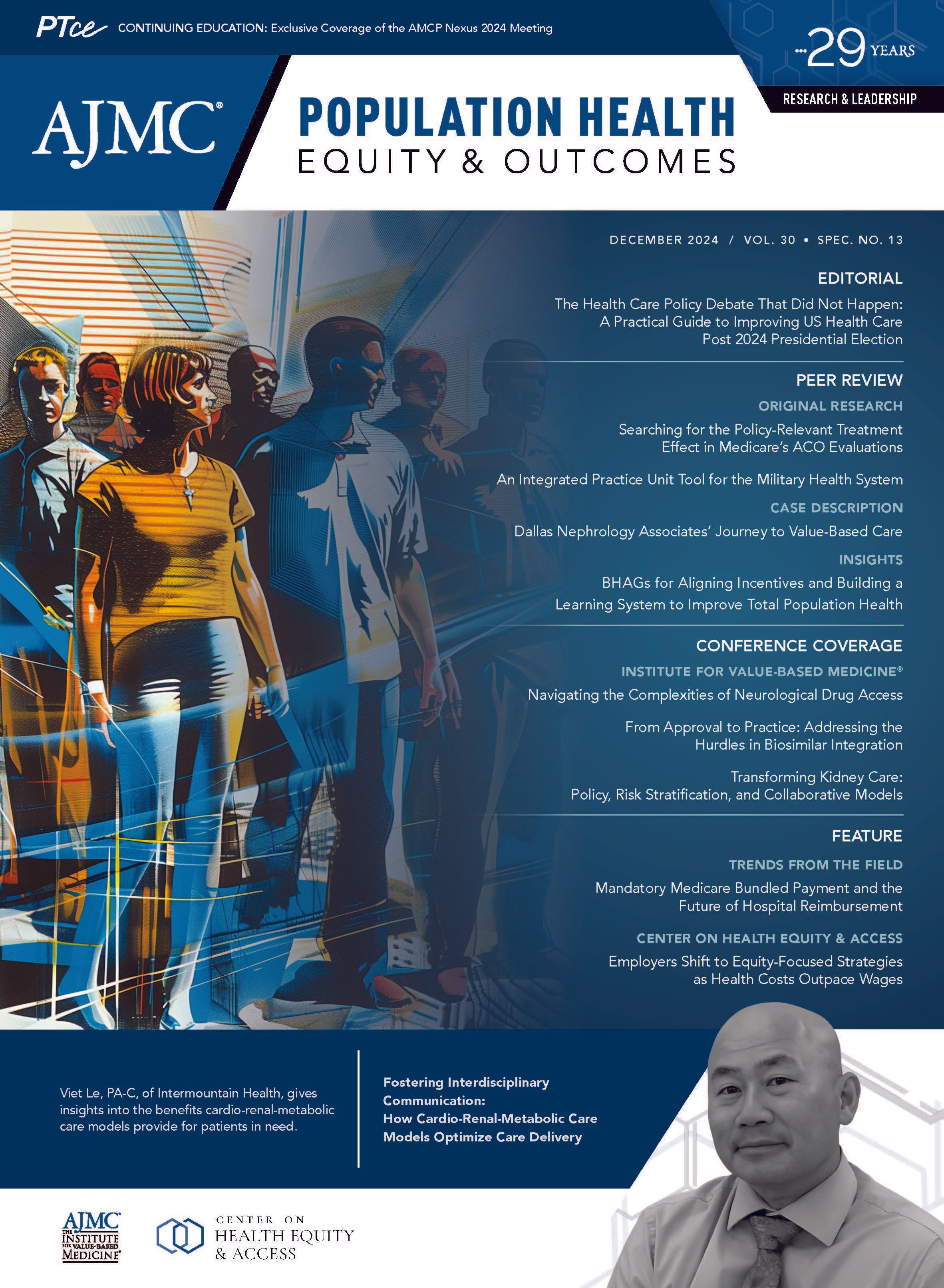Publication
Article
Population Health, Equity & Outcomes
The Need for Regulation to Positively Impact Drug Formulary Decisions to Ensure Appropriate Patient Access: A Little-Discussed Topic in Pharmaceutical Policy and Pricing Debate
Author(s):
As health care moves toward a value-based payment model, the pharmacy benefit is going in the opposite direction, one that places unit cost over clinical appropriateness.
Have you ever used your drug benefit? Have you had to change a medication due to changes in your drug formulary? It is likely that you or a family member would answer yes to both questions. The drug benefit is the most utilized portion of health insurance in the US. In 2023, more than 60% of individuals took at least 1 medication, with 37% taking 3 or more.1 This means that most Americans with health insurance have to interact with a drug formulary.
This was not always the case. It was not until the 1970s that health insurance began covering medications. Prior to that, if an individual needed a prescription, they paid the full price out of pocket. As more drugs came to market, it became clear that there was a need for financial coverage of medications for both patients and insurance organizations. This led to the creation of the pharmacy benefit manager (PBM) in the 1990s. The PBM’s role was to act as a negotiating intermediary with the pharmaceutical manufacturers. This reduced the unit price of medications through volume purchasing. In addition to cost reduction activities, PBMs created the drug list or formulary that was used as part of the drug benefit.
Most recently, PBMs have received an increasing amount of scrutiny. Two areas that have received significant attention are the PBMs’ impact on drug pricing and the lack of transparency in their business practices. One issue that has not received a great deal of attention is the misuse of the drug formulary—the foundation of the drug benefit—which consists of a list of medications covered by one’s health insurance. Although some would say that the purpose of drug formularies has remained the same over the past 30-plus years, others would disagree. Initially, drug formularies were developed by a pharmacy and therapeutics committee of a PBM, health plan, or other organization. The committee was made up primarily of clinicians and other experts who determined the safety, efficacy, and unique clinical aspects of the drug. If it met their standards, it was placed on the formulary. It was rare that a drug that was FDA approved and met these criteria was excluded. The drug formulary was created as a clinical tool, and the methodology associated with its creation brought consistency and trust to the model. Unfortunately, this is no longer the case. Drug formularies today are a financial tool tied directly to drug rebates and have little or no alignment with clinical support. In fact, they often are in direct conflict with the goal of a patient receiving the medicine that will help them the most. What started as a tool has now become a weapon.
Drug formularies are not the sole means of managing the drug benefit. Drug utilization management (UM) programs are often used in conjunction with drug formularies to ensure clinical effectiveness and efficiency. The 2 most common UM programs are prior authorization and step therapy. Prior authorization is often used to ensure that the medications being prescribed and dispensed align with the appropriate medication-diagnosis matching and nationally recognized guidelines.
Over the past decade, the science behind drug development and the clinical decision-making associated with drug management have evolved. The increasing knowledge of the human genome and chemical and clinical biomarkers has better defined what medications work under specific conditions for specific patients. Study results have shown that most medications have only a 50% chance of efficacy, and patients often must try 2 or 3 medications prior to finding one that is effective for them. The use of pharmacogenetics and pharmacokinetics has increased the likelihood of clinical success, with reduced complication and adverse effect profiles. The improved science associated with prescribing not only has an impact on clinical outcomes but also reduces total health care spending significantly through more targeted prescribing. A 2023 article published on AJMC.com, the website of The American Journal of Managed Care®, discussed significant improvements in health care costs and clinical outcomes by using pharmacokinetics and pharmacogenetics.2 The era of population-based prescribing is quickly coming to its conclusion. Unfortunately, these scientific methodologies are rarely utilized in creating a formulary or the associated UM programs.
Although a more personalized and precise medication management paradigm has evolved, drug formularies have drifted from the clinical model to one that is more commonly tied to financial attributes, not clinical reasoning. Over the past 10 years, there has been an increase in medications being excluded from drug lists for nonclinical reasons. In fact, more than 600 FDA-approved medications are now excluded on an annual basis from the formularies of the larger PBMs. These exclusions have no clinical basis and are based primarily on the amount of drug rebate available to the PBM. Today’s formulary is based on a financial bidding war. This creates a situation where a patient may have no access to the medication that can improve or cure their condition.
Joanne is a 49-year-old woman with diabetes who takes 3 medications to control this chronic condition. Her diabetes was well controlled on her medications for several years until January 2023. At that time, one of her diabetes medications was removed from the formulary and no longer covered by her insurance. She was notified that she had to change one of her brand medications for nonmedical reasons. To make this change, Joanne had to have 3 visits with her primary care provider and 4 blood tests to determine what would be the replacement medication. After significant out-of-pocket costs and 7 months, Joanne’s diabetes was once again under control.
As seen in this example, nonmedical switching due to a financial arrangement and not clinical reasoning places patients in a position of not being able to receive medications that meet their scientific, clinical, or financial need. It not only costs the patient their health and money, but it also costs the payer money. This new model may reduce the unit cost of a medication through rebates and volume purchasing, but it increases the cost of the treatment as a whole and reduces the value of the medication. Financial arrangements that have clinical implications such as this bring into question whether payers are meeting their fiduciary responsibility by having the interest of the patient aligned with their actions. This has become an increasing concern as laws such as the Consolidated Appropriations Act of 2022 state that employers act as fiduciary for their employees.
The past few years have brought increasing scrutiny to the drug benefit for lack of transparency of the industry’s business practices. In response, several potential legislative solutions focused on the PBM industry have been proposed. The 2018 Patient Right to Know Drug Prices Act and the Know the Lowest Price Act of 2018 are legislative solutions focused on cost transparency. These changes are necessary, but they are not enough. Unfortunately, to date, there is no legislation focused on the appropriate use of drug formularies. Today’s formularies are a tool for organizations to make money and not a tool for patients to have access to correct medications for their conditions. A less expensive medication that is the wrong medication costs patients, payers, and society money. Legislatures should consider implementing laws that:
- Remove the relationship between drug formularies
and rebates - Remove the relationship between drug utilization management programs and rebates
- Ensure no FDA-approved medications are excluded from a formulary
- Make the appeals process available for all patients taking medications
- Prohibit nonmedical switching
These legislative actions should lead to the formulary’s return to a clinical foundation and help to align with better coverage of appropriate medication usage. Unfortunately, incentives are not all aligned. Today’s model of rebate-based formularies can bring significant value to the PBM industry through revenue generation and potentially short-term gains to payers as they share in the rebate revenue. This model does not help the patient and their physician, who is trying to treat the patient with the medication most appropriate for them. In addition, this financial-first pharmacy benefit model does not help the payer (ie, employer, government, value-based provider, or insurance company) in the long term because the wrong drug creates poor outcomes and increased long-term costs.
Science is advancing in exciting ways. Medications are being discovered that treat conditions that either were undertreated or had no treatment at all. This creates the opportunity to improve health and decrease costs. This is the true definition of value. It is time that drug formularies focus on appropriate-use vehicles and not a financial instrument. We need to create a model where all parties have their clinical and financial needs met. Legislative remedies can help pave the way to a pharmacy-based value benefit.
Author Information
Dr Berger is the CEO of Health Intelligence Partners in Chicago, Illinois, and a member of the editorial board of Population Health, Equity & Outcomes.
REFERENCES
- Kirzinger A, Montero A, Sparks G, Valdes I, Hamel L. Public opinion on prescription drugs and their prices. KFF. August 21, 2023. Accessed September 18, 2024. https://www.kff.org/health-costs/poll-finding/public-opinion-on-prescription-drugs-and-their-prices/
- Apted T, Huff A. Pharmacogenomics for improved outcomes and decreased costs in health care. AJMC. December 15, 2023. Accessed September 18, 2024. https://www.ajmc.com/view/pharmacogenomics-for-improved-outcomes-and-decreased-costs-in-health-care






